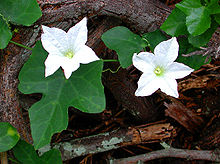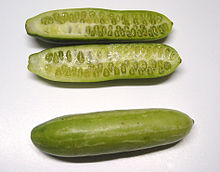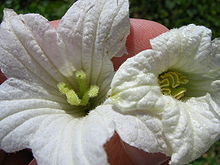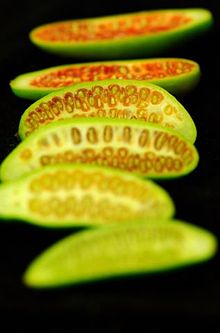- Coccinia grandis
-
Coccinia grandis 
Scientific classification Kingdom: Plantae (unranked): Angiosperms (unranked): Eudicots (unranked): Rosids Order: Cucurbitales Family: Cucurbitaceae Genus: Coccinia Species: C. grandis Binomial name Coccinia grandis
(L.) J.VoigtCoccinia grandis, the ivy gourd, also known as baby watermelon, little gourd or gentleman's toes is a tropical vine.
Contents
Geographic spread
Coccinia grandis' native range extends from Africa to Asia including India, Philippines, China, Indonesia, Malaysia, Thailand, Vietnam, eastern Papua, New Guinea and Northern Territories (Australia) (PIER, 2003). Its documented introduced range includes the Federated States of Micronesia, Fiji, Guam, Saipan, Hawai‘i, Marshall Islands, Samoa, Tonga, and Vanuatu (PIER, 2003).
Seeds or fragments of the vine can be relocated and lead to viable offspring. This can occur when humans transport organic debris or equipment containing C. grandis. Once Ivy Gourd is established, it is presumed that it is spread by birds, rats and other mammals. In Hawaii, PIER (2001) suggests that the fruit may be dispersed by pigs. Long distance dispersal is most commonly carried out by humans due to its culinary uses or by mistake.
Regarded as very invasive and on the Hawaii State Noxious Weed List, Ivy gourd can grow up to four inches per day. Coccinia grandis grows in dense blankets that shade other plants from sunlight and high-jacking nutrients. Native to tropical Africa and Asia, it was introduced to Hawai'i as a backyard food crop. It is sometimes tolerated along garden fences and other outdoor features because of its attractive white flowers. It has escaped to become a vigorous pest in Hawai'i, Florida, Australia, and Texas. In Hawai'i, this plant has spread quickly through Manoa Valley to Punchbowl and into Waimanalo, Oahu, and also into the Kona area. Ivy Gourd's environmental effects are that it smothers and forms a dense canopy smothering and effectively killing vegetation underneath. (NMC Crees, 1997).
Weed control
There are both physical and chemical recommendations for control of Ivy Gourd. It is very difficult to control this plant physically except for bagging fruits. Hand-harvesting normally does not kill the plant but rather breaks the vine blankets into smaller pieces and the plant is able to reestablish when it touches the ground. These methods can make the infestation worse and further the need for more rigorous control methods. Picking the fruit and placing them in plastic bags can help decrease the seed back that is present with the soil. It is reported by PIER, that when utilizing chemical controls, that Ivy Gourd responded well to a thin-lined bark application of 100% Garlon 4 (triclopyr), leaving plants in place so as not to translocate the herbicide or spread the pest. It is applied multiple times until the vine dies. In Hawaii several species of insect have been introduced with the purpose of being a biocontrol. Two weevils, Acythopeus burkhartorum and A. cocciniae, were introduced by the DOA to Oahu and Hawai'i. African vine moths (Melittia oedipus) were also released onto Oahu and Maui. On the island of Maui it appears that the A. cocciniae is established and are damaging leaves. The larva feed on the plant and the adults chew holes in the leaves. The moth has yet to appear successful in its purpose.
Cultivation
Cultivation in Southeast Asia, ivy gourd is grown for its edible young shoots and edible fruits (Linney 1986).
Medicinal value
In traditional medicine fruits have been used to treat leprosy, fever, asthma, bronchitis and jaundice. The fruit possesses mast cell stabilizing; anti anaphylactic and antihistaminic potential.[1] Ivy gourd extracts and other forms of the plant can be purchased online and in health food stores. It is claimed that these products help regulate blood sugar levels. There is some research to support that compounds in the plant inhibit the enzyme glucose-6-phosphatase (Shibib et al, 1993). Glucose-6-phosphatase is one of the key liver enzymes involved in regulating sugar metabolism. Therefore, Ivy Gourd is sometimes recommended for diabetic patients. Although these claims have not been supported, there currently is a fair amount of research focused on the medicinal properties of this plant focusing on its use as an antioxidant, anti-hypoglycemic agent, immune system modulator, etc.[citation needed] Some countries in Asia like Thailand prepare traditional tonic like drinks for medicinal purposes.
Regional names
- Giloda ગીલોડા - Gujarati - ગુજરાતી
- toruli / kundri- (Bengali),
- tindora (tindori, tindoori) - (Hindi),
- kundru -(Punjabi),
- tondli (तोंडली ) - (Marathi),
- toroda/kunduri - (Oriya),
- thendli, tendli - (Konkani),
- kovai, kovakkai(കോവയ്ക്ക) - (Malayalam),
- kovakka -(Tamil),
- dondakaya (దొండకాయ) -(Telugu),
- tondekayi (ತೊಂಡೆಕಾಯಿ) -(Kannada),
- tam lueng (ตำลึง) - (Thai),
- Bimbi बिम्बी - Sanskrit
Recipes
There are a variety of recipes from all over the world that list Ivy Gourd as the main ingredient. It is often compared to bitter melon. The fruit is commonly eaten in Indian cuisine. People of Indonesia, and other southeast Asian countries also consume the fruit and leaves. Cultivation of ivy gourd in home gardens has been encouraged in Thailand due to its being a good source of several micronutrients, including vitamins A and C.[citation needed]
In India it is eaten as a curry, by deep-frying it along with or without chilli & garlic, garlic giving it excellent taste; stuffing it with masala and sauteing it ; or boiling it first in a cooker and then frying it. It is also used in sambar, a vegetable and lentil-based soup.[citation needed]
Nutrition
Ivy gourd is rich in beta-carotene.[2]
External links
- Coccinia grandis (L.) Voigt (ivy gourd) - USDA plants
- Information at the University of Hawai'i
- Image at FoodWeb, University of Birmingham, UK
- Multilingual taxonomic information from the University of Melbourne
References
- ^ Taur D.J., Patil R.Y.,"Mast cell stabilizing, antianaphylactic and antihistaminic activity of Coccinia grandis fruits in asthma". Chinese Journal of Natural Medicines. 9 (5) (pp 359-362), 2011.
- ^ Artemis P. Simopoulos and C. Gopalan, ed. (2003), Plants in Human Health and Nutrition Policy, Karger Publishers, ISBN 3-80-557554-8
- Linney, G. 1986. Coccinia grandis (L.) Voight: A new cucurbitaceous weed in Hawai'i.
Hawaii. Bot. Soc. Newslett. 25(1):3-5.
- PIER (Pacific Island Ecosystems at Risk). 2003. "Invasive plant species: Coccinia
grandis." Pacific Island Ecosystems at Risk. Available: http://www.hear.org/pier/ (Accessed: Feb 10, 2010).
- NMC Crees, 1997. Scarlet Gourd in Saipan.
Summary: About the Scarlet Gourd in Saipan. Available from: http://www.crees.org/weeds/scarlet-gourd.htm [Accessed Feb. 10 2010]
- Shibib, BA, Khan, LA, Rahman, R. Hypoglycemic activity of Coccinia indica and Momordica charantia in diabetic rats: depression of the hepatic gluconeogenic enzymes glucose-6-phosphatase and fructose-1,6-bisphosphatase and elevation of both liver and red-cell shunt enzyme glucose-6-phosphate dehydrogenase. Biochem J. 1993 May 15; 292(Pt 1): 267-270. PMC1134299
Categories:- Fruit vegetables
- Cucurbitaceae
Wikimedia Foundation. 2010.



